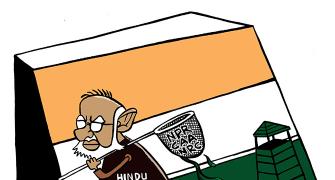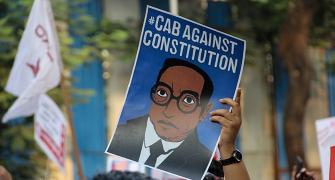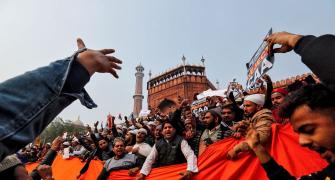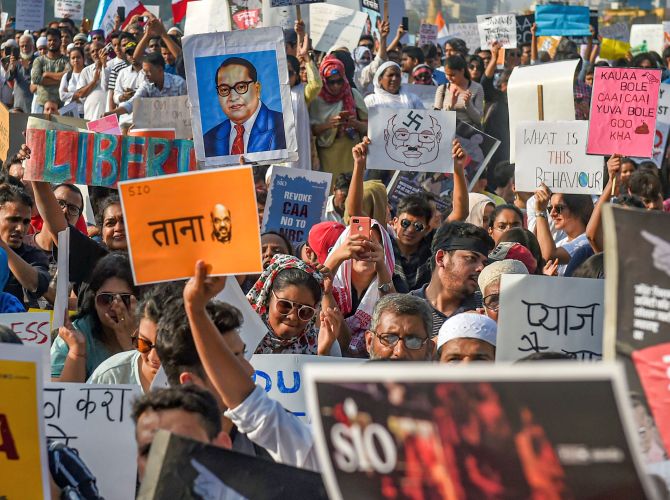The anti-CAA protest was an ugly rant more consistent with the violent chaos of anarchy, argues Vivek Gumaste.
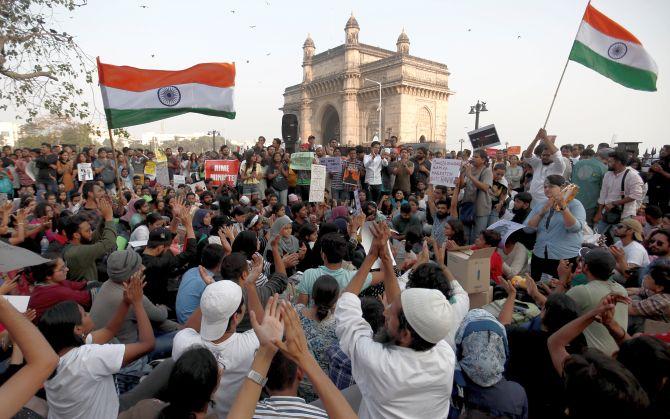
Protest is a mesmerising word, the clarion call of a revolutionary, the lifeline of a democracy and the buzzword for free speech.
But the mere word 'protest' cannot sanctify every agitation, does not validate every dissent and does not justify any means including violence.
For a protest to be valid it must be peaceful, informed and logical; it must be guided by sincerity and devoid of prejudice and deception.
By these criteria the current agitation against the Citizenship (Amendment) Act scores an abysmal zero; an astounding failure of gargantuan proportions.
Drilled down to the core, this protest turns out to be a dangerous cocktail of violent blackmail, naked political opportunism and revolting schadenfreude that celebrates the woes of persecuted minorities, especially Hindus from neighbouring nations.
Visuals of a few thousand people out on the streets makes for a captivating picture; the same picture retweeted hundred times and played up by the media with a host of hyper excited news reporters screeching at the top of their voices multiplies its effect.
But how much of our entire population do they constitute? Is an organised vocal minority trying to hijack democracy by violent blackmail and mobocracy?
What is the message that we wish to send out? That Parliament is not supreme. Mobs rule the roost. Civilised channels of protest like the courts are not to be used.
And anytime and every time we don't like a legitimately passed law, let us come on to the streets, burn a few buses, dub it as communal and discriminatory and derail democracy.
This dangerous descent into anarchy instigated by rabble-rousers masquerading as defenders of democracy must be unmasked and stopped in its tracks.
More than three weeks have passed since the protests began. It is time to dissect the anatomy of the protest and unravel its ugly innards to expose what it actually is.
First, let us analyse the physical construct of this protest. The hundred million-dollar question that begs for an answer: Was this a peaceful protest?
With more than 23 deaths and counting, innumerable buses torched, railway stations vandalised and private cars and vehicles damaged, the answer has to be a categorical no
Second, this was not an impromptu expression of discontent. There are telltale signs that are troubling and which suggest a larger premeditated game-plan in play as these excerpts from news reports indicate:
The visuals beamed on television (external link) show that many of them are using arms -- stones, bricks, lathis and some inflammable materials too.
Kumar Gyanesh, additional DCP (Delhi-South East), said, 'Some protesters were carrying wet blankets and putting them on tear gas shells to minimise their impact. It did not seem to be spontaneous, but well planned. Protesters had petrol bombs, which were hurled at us. These things do not happen on the spot, it shows that it was a conspiracy' (ANI's tweet, December 17).
Around 269 policemen were reportedly injured in Uttar Pradesh and 57 received bullet injuries. The Uttar Pradesh police also seized 405 country-made revolvers and pistols. The autopsies of the 18 dead reveal that most of the deceased were hit by these country-made bullets.
Director General of Police O P Singh claimed (external link) women and children were used as 'shields by the protestors'.
Days after the violent protests in Mangaluru against the Citizenship (Amendment) Act resulted in the death of two people, the police released video footage (external link) purportedly showing protesters bringing stones in an auto-trolley, hurling it at personnel and trying to destroy the CCTV cameras.
The video also shows protesters covering their face with clothes to conceal their identity and attempting to destroy CCTV cameras in a bid to wipe out evidence.
These reports indicate that this was not a totally spontaneous protest, but one that was carefully planned with protestors who carried not only bricks, lathis and stones but petrol bombs and country-made rifles as well.
Protestors armed with pistols is a first for this country; a dangerous, deplorable tend which maybe the beginnings of a gun culture (57 policemen received bullet injuries) that does not augur well for our democracy. All right-thinking Indians of all political and ideological persuasions must take note of this dark reality.
The modus operandi also is concerning: In Maoist style, the protestors specifically targeted and attacked police stations (Yatimkhana, Kanpur and Mangaluru North police station) which are seen as symbols of law and order. This cannot be justified as self-defence.
Now details are emerging (external link) that radical Islamic groups like Popular Front of India and SIMI which is banned may be involved in these protests and that there maybe a Pakistani link to this entire brouhaha:
Hate-filled anti Hindu slogans were a prominent feature of this protest, underlining its Hinduphobic construct; singing the national anthem and waving the tricolour in tandem with hate rants is an insult to our national symbols and cannot mitigate the venom of these outpourings.
Ubiquitous and overwhelming ignorance was central to this protest. Rumour-mongering carried the day. No one actually knew what the bill was about or what they were protesting. Some students even exhibited a shocking lack of awareness; they appeared to be in the protest for the adrenalin rush that it provided.
The role of a certain section of the media is highly questionable. Instead of elucidating the details of the CAA and allaying public concerns, it acted like an agent provocateur; it spun a web of lies based on specious speculation that fed into the insecurities of Muslims and provoked righteous indignation among several Indians.
Additionally, the protest was imbued with a larger than life image by invoking student power and alleging police brutality -- two key incendiary factors in any protest movement.
Especially telling is the attempt by a senior journalist to eulogise two women students of Jamia Milia University as heroic defenders of democracy; she even called them 'sheroes'. A perusal of their Facebook profiles, however, revealed their true persona. So much for idealistic journalism and idealistic students.
The political Opposition did not cover itself with glory during this protest, either. After having been decisively defeated in the Lok Sabha election, the Opposition was waiting for an opportunity to corner the government. The CAA provided a perfect segue to channel its frustrations.
Sonia Gandhi remarked on December 20, 'In a democracy people have the right to raise their voice against wrong decisions and policies of the government and register their concerns. The BJP government has shown utter disregard for people's voices and chosen to use brute force to suppress dissent.'
Fair enough. But missing from her statement was a call for restraint; it almost appeared that the Opposition was gloating silently at the government's discomfiture in the face of this violence.
While not denying that there was a degree of spontaneity and sincerity in the anti-CAA protests, the hyped magnitude was a conjured illusion floated by a decisively defeated Opposition, a slighted intelligentsia that is becoming increasingly irrelevant, and rabid fundamentalists out to exploit the situation with probably a little help from Pakistan.
Playing along with this charade was a certain section of the media: A privileged English-speaking elite with a sense of entitlement mired in its own hubris and delusionary omnipotence which cannot stomach the idea of an independent leader not subject to their whims or the ascendancy of vernacular, indigenous India.
The bottom line. This was by no stretch an altruistic and sublime expression of free speech. It was an ugly rant more consistent with the violent chaos of anarchy.
Academic Vivek Gumaste, who is based in the United States, is the author of My India: Musings of a Patriot.

